
High-volume users, such as hospitals, experience significant gains from electric staplers. In 2023, hospitals contributed 55% of the global medical electric stapler market revenue, driven by efficiency and precision. 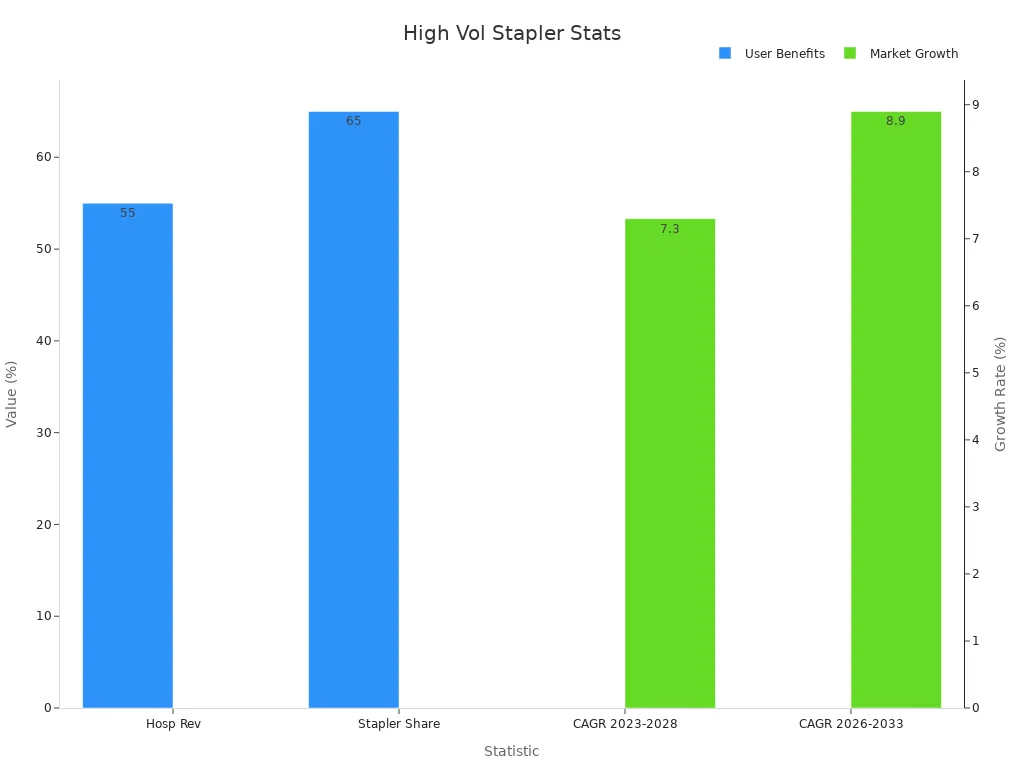 Occasional users or those with limited space may not require this tool. Choosing the right stapler depends on individual needs and work environments.
Occasional users or those with limited space may not require this tool. Choosing the right stapler depends on individual needs and work environments.
Key Takeaways
- Electric staplers save time and effort by stapling faster and with less hand strain, making them ideal for high-volume or frequent use.
- They provide consistent, neat stapling results and include safety features that protect users and reduce jams.
- Consider your stapling volume, workspace, budget, and comfort needs before choosing between electric and manual staplers to find the best fit.
Understanding the Electric Stapler
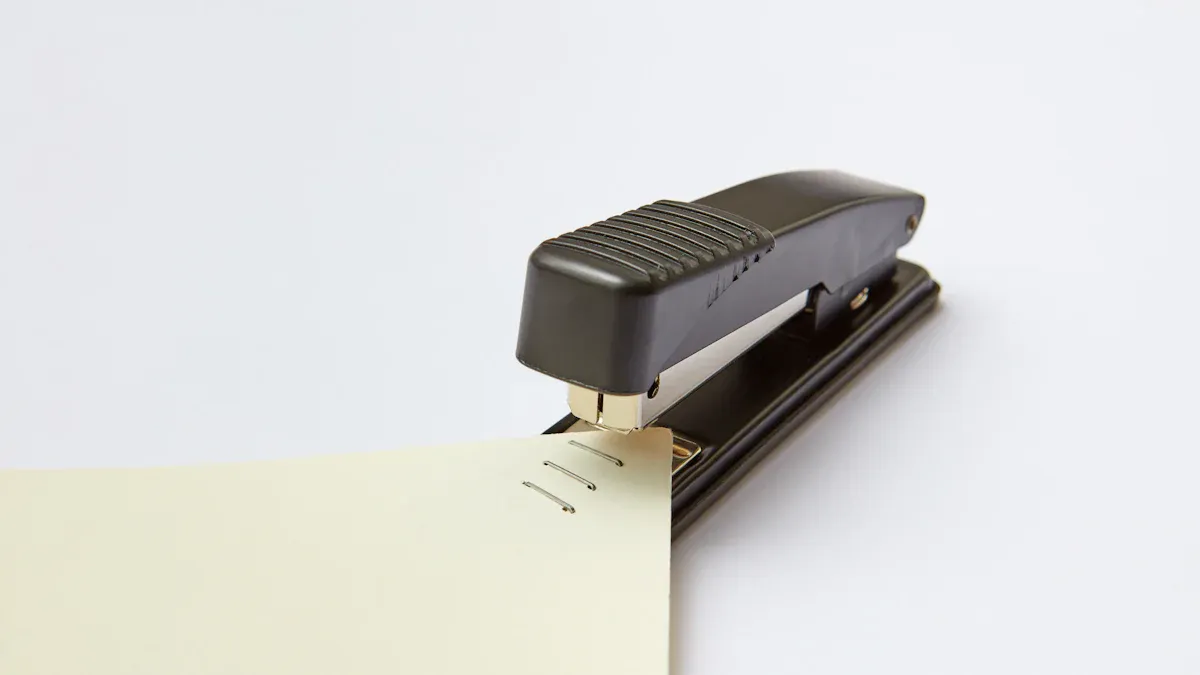
Key Features of Electric Staplers
Electric staplers have evolved to meet the demands of modern workplaces. Manufacturers now focus on efficiency, comfort, and user-friendly design. Many models, such as the Ryobi P317, offer adjustable power settings for precise staple placement. Users can expect instant firing, long battery life, and ergonomic grips that reduce fatigue. Some electric staplers include features like LED low staple indicators, jam-free mechanisms, and adjustable stapling depth. The Swingline Optima 45, for example, staples up to 45 sheets at once and operates quietly, making it suitable for busy offices.
Note: Recent advancements include smart sensors that adjust pressure based on paper thickness and sustainability features like recycled materials.
- Key features highlighted in user reviews and performance tests:
- Consistent staple depth and power settings
- Fast, lag-free operation
- High sheet capacity and jam-free performance
- Ergonomic grips and intuitive controls
- Visual indicators for staple supply
Electric vs. Manual Stapler Differences
Electric and manual staplers differ in several important ways. Electric models require less physical effort and deliver more consistent results. Comparative studies in clinical and office settings show that powered staplers reduce complications and improve precision. For example, in surgical applications, powered staplers lower the risk of bleeding and reduce hospital costs.
The table below summarizes key performance differences:
| Metric | Powered Stapler Group | Manual Stapler Group | Statistical Significance (p-value) |
|---|---|---|---|
| Total Hospital Costs | $10,708 | $12,124 | < 0.001 |
| Supply Costs | $3,875 | $4,736 | 0.001 |
| Operating Room Time (minutes) | 121.6 | 130.5 | 0.092 (not significant) |
| Bleeding and/or Transfusion (%) | 1.34% | 2.31% | 0.013 |
Electric staplers also adapt to digital workflows and sustainability trends, while manual models remain simple and portable. The choice depends on user needs, volume, and workspace.
Benefits of Using an Electric Stapler
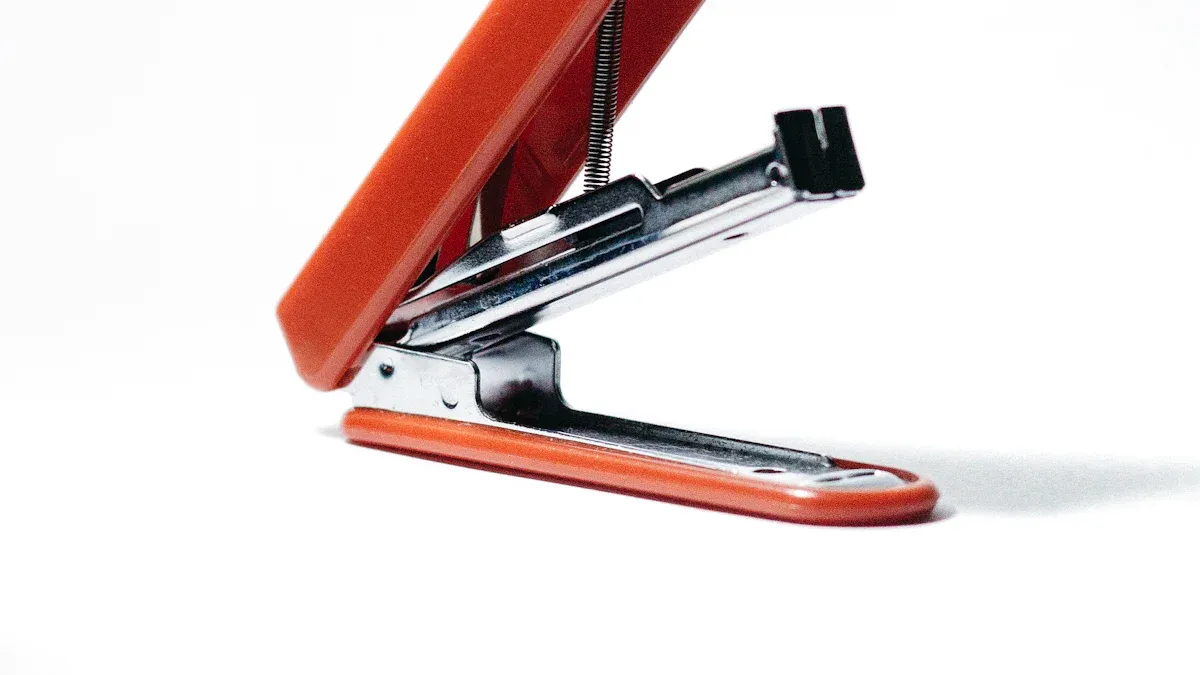
Increased Speed and Efficiency
Electric staplers deliver remarkable speed, making them ideal for busy offices and high-volume environments. Many models staple up to 40 sheets per minute, with some reaching speeds as high as 60 staples per minute. This rapid performance allows users to process large stacks of documents quickly. Impulse Drive and automatic induction technologies further boost efficiency, enabling immediate document removal and eliminating the need for manual pressing.
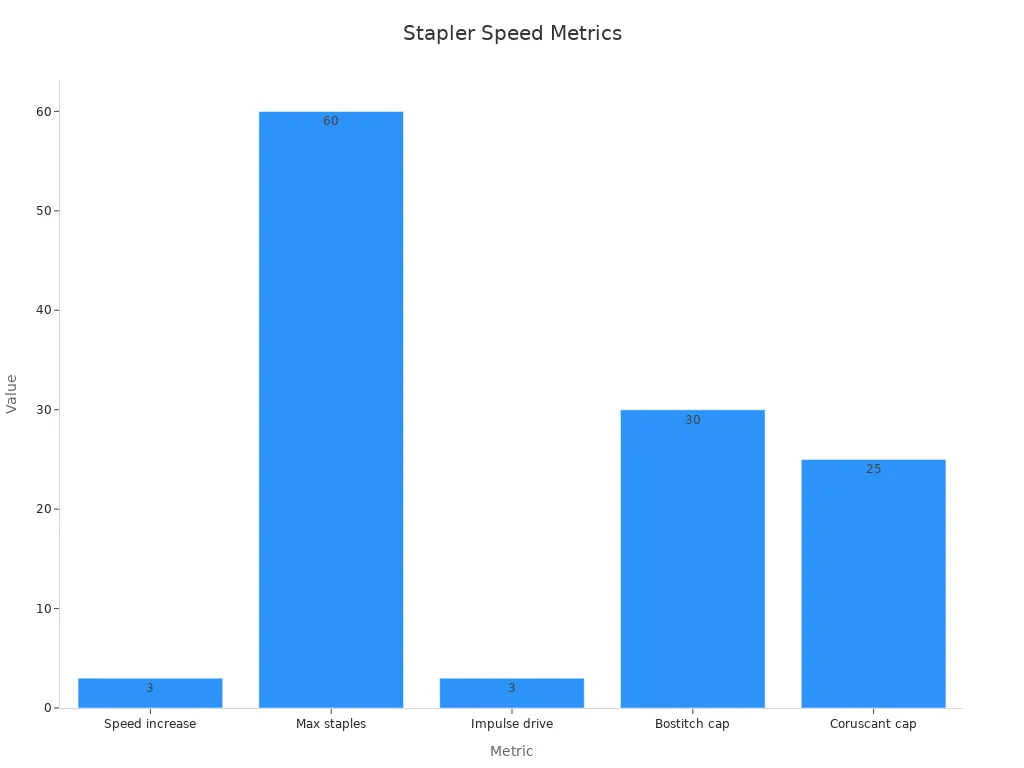
| Statistic / Feature | Description / Value |
|---|---|
| Stapling speed increase | Electric staplers staple up to 3 times faster than manual staplers |
| Maximum staples per minute | Some models achieve up to 60 staples per minute |
| Impulse Drive Technology | Provides 3X faster stapling speed and immediate document removal |
| Automatic induction technology | Enables rapid stapling without manual pressing |
| Sheet capacity (Bostitch model) | Staples up to 30 sheets at once |
| Sheet capacity (Coruscant model) | Staples up to 25 sheets at once |
| Additional features | Quick reload mechanisms, no jam technology, refill alerts, automatic stapling detection |
These features translate into significant time savings, especially for users who handle large volumes of paperwork daily.
Consistent Stapling Results
Electric staplers provide uniform results with every use. The motorized mechanism ensures each staple penetrates paper stacks at the same depth and angle. This consistency reduces the risk of misaligned or incomplete staples, which can cause document damage or require re-stapling. In clinical and office settings, studies show that powered staplers improve outcomes by reducing complication rates and hospital stays. The table below highlights these improvements:
| Metric | Powered Stapler Group | Manual Stapler Group | Statistical Significance (p-value) |
|---|---|---|---|
| Total Hospital Costs | $10,708 | $12,124 | < 0.001 |
| Supply Costs | $3,875 | $4,736 | 0.001 |
| Operating Room Time (minutes) | 121.6 | 130.5 | 0.092 (not significant) |
| Bleeding and/or Transfusion (%) | 1.34% | 2.31% | 0.013 |
These results demonstrate that electric staplers not only save time but also deliver reliable, high-quality performance.
Reduced Hand Strain and Ergonomics
Manual stapling can cause hand fatigue, especially during repetitive tasks. Electric staplers eliminate the need for physical force, reducing strain on the hands and wrists. Ergonomic designs, such as contoured grips and intuitive controls, further enhance user comfort. This benefit proves especially valuable for individuals with arthritis or limited hand strength. By minimizing repetitive motion, electric staplers help prevent workplace injuries and support long-term health.
Tip: For users with high stapling demands or ergonomic concerns, choosing an electric stapler can significantly improve daily comfort and productivity.
Higher Stapling Capacity
Electric staplers excel in handling large document stacks. Advanced models, such as the Rapid 5050E Professional Electric Stapler, staple up to 60 sheets at once and hold up to 5,000 staples in a single cartridge. These devices also feature patented cartridge designs and SuperFlatClinch technology, which keeps paper stacks neat and flat.
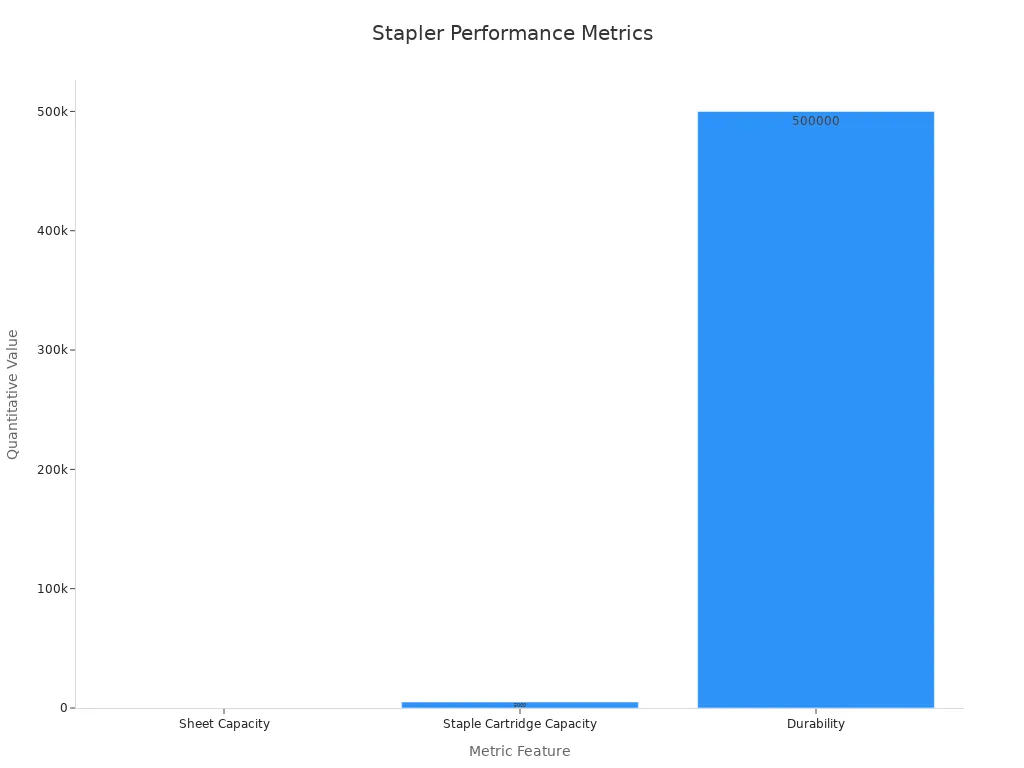
| Metric/Feature | Rapid 5050E Professional Electric Stapler |
|---|---|
| Sheet Capacity | Staples up to 60 sheets at a time |
| Staple Cartridge Capacity | Holds 5,000 staples |
| Durability | Can staple at least 500,000 times |
| Technology Features | Patented cartridge design with new driver head |
| Stapling Quality Technology | SuperFlatClinch technology for neat paper stacks |
| Maintenance | Front-loading design for easy staple replacement |
These features make electric staplers a practical choice for users who need to staple thick reports or large batches of documents.
Enhanced Safety Features
Modern electric staplers include safety mechanisms that protect users from accidental injury. Many models feature automatic shut-off sensors, shielded staple exits, and jam-free designs. These enhancements reduce the risk of finger injuries and minimize downtime caused by jams. In environments where safety is a priority, such as schools and hospitals, these features provide peace of mind.
Portability and Versatility
While electric staplers require power or batteries, many models offer compact designs and cordless operation. This portability allows users to move the stapler between workstations or take it on the go. Versatile features, such as adjustable stapling depth and compatibility with various staple sizes, make these devices suitable for a wide range of tasks. Users can staple everything from thin packets to thick manuals with ease.
Note: Some electric staplers use rechargeable batteries, making them both portable and environmentally friendly.
Drawbacks of Electric Staplers
Dependence on Power or Batteries
Electric staplers rely on a consistent power source or charged batteries. Users must ensure access to electrical outlets or keep batteries charged for uninterrupted operation. In environments with frequent power outages or limited access to charging stations, this dependence can disrupt workflow. Manual staplers do not face this limitation, making them more reliable in certain situations. Users who travel or work in remote locations may find the need for power a significant inconvenience.
Upfront Cost and Ongoing Expenses
The initial investment for an electric stapler often exceeds that of a manual model. Market reports identify high upfront costs as a major barrier for many buyers. Ongoing expenses, such as replacement batteries, maintenance, and repairs, add to the total cost of ownership. These factors can limit accessibility, especially for small businesses or organizations with tight budgets.
- High initial investment presents a significant barrier for many users.
- Ongoing maintenance and operational expenses increase the total cost.
- Smaller enterprises and price-sensitive regions may find these costs prohibitive.
- Market analysis highlights these challenges but does not provide specific cost figures.
Note: Buyers should consider both the purchase price and long-term expenses before choosing an electric stapler.
Maintenance and Jamming Issues
Electric staplers require regular maintenance to function smoothly. Technical studies and device reports highlight common malfunctions, including failure to fire, partial firing, and mechanical jams. Devices such as Medtronic’s Endo GIA™ and Signia™, as well as Intuitive’s robotic staplers, have experienced hundreds of incidents involving jams or misfires. Users sometimes encounter difficulties during setup or preparation, often related to powered handles.
- Common malfunctions include failure to fire, misfires, and jams.
- Device setup and preparation can present challenges.
- Reports describe malfunction rates but do not offer detailed maintenance solutions.
Routine cleaning and proper use can reduce the risk of jams, but no device is completely immune to these issues.
Size and Limited Portability in Tight Spaces
Electric staplers tend to be larger and heavier than manual models. Their size can limit portability, especially in cramped workspaces or when users need to move the device frequently. Some models offer compact designs, but most still require more room than a traditional stapler. Users with limited desk space or those who value mobility may find this drawback significant.
Noise Considerations
Electric staplers generate noise during operation. The sound of the motor and the stapling mechanism can disrupt quiet environments, such as libraries or shared offices. While some models advertise quieter performance, they rarely match the near-silent operation of manual staplers. Users who prioritize a quiet workspace should consider this factor before making a purchase.
Stapler Decision Guide: Is It Right for You?
Assessing Your Stapling Volume and Frequency
Users should start by evaluating how often they staple documents and the typical volume per session. High-frequency users, such as those in medical or administrative settings, benefit most from electric models. Usage studies in surgical environments reveal that professionals select stapling systems based on operational needs, cartridge usage, and environmental considerations. For occasional or low-volume tasks, a manual stapler may suffice.
Budget and Cost Considerations
Cost plays a significant role in the decision process. Electric staplers often require a higher initial investment, with prices reflecting advanced features and precision. A cost-benefit study in a hospital setting found that, despite higher upfront costs, powered staplers reduced total expenses through savings in drug costs and shorter hospital stays. Decision-makers should consider not only purchase price but also total cost of ownership, including warranty, repair, and training support.
Workspace and Portability Needs
Workspace constraints and mobility requirements influence stapler selection. Electric models tend to be larger and may need dedicated space or access to power. Compact or cordless options offer flexibility for users who move between locations. Those with limited desk space or who value portability may prefer smaller, manual alternatives.
Comfort, Safety, and Accessibility
Comfort and safety features matter, especially for users with repetitive tasks or physical limitations. Electric staplers reduce hand strain and often include safety mechanisms to prevent injury. General decision-making tools help users weigh these factors, organizing priorities such as ergonomics, safety, and accessibility to match the right stapler to their needs.
- High-volume users and those seeking ergonomic support gain the most from electric staplers.
- Matching device features to specific needs ensures optimal results.
Readers should review the decision guide before making a purchase. Careful evaluation leads to better productivity and satisfaction with the chosen stapler.
FAQ
How often should users maintain an electric stapler?
Regular cleaning every few weeks keeps the device running smoothly. Users should follow the manufacturer’s instructions for best results and to prevent jams.
Can electric staplers handle different staple sizes?
Most electric staplers accept multiple staple sizes. Users should check the product specifications to ensure compatibility with their preferred staple type.
Are electric staplers safe for children to use?
Manufacturers design electric staplers with safety features. However, adult supervision remains necessary when children operate these devices to prevent accidental injury.
Post time: Jul-01-2025